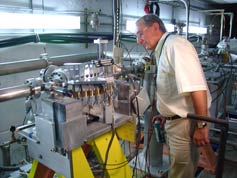
Handy Links
SLAC News Center
SLAC Today
- Subscribe
- Archives: Feb 2006-May 20, 2011
- Archives: May 23, 2011 and later
- Submit Feedback or Story Ideas
- About SLAC Today
SLAC News
Lab News
- Interactions
- Lightsources.org
- ILC NewsLine
- Int'l Science Grid This Week
- Fermilab Today
- Berkeley Lab News
- @brookhaven TODAY
- DOE Pulse
- CERN Courier
- DESY inForm
- US / LHC
SLAC Links
- Emergency
- Safety
- Policy Repository
- Site Entry Form

- Site Maps
- M & O Review
- Computing Status & Calendar
- SLAC Colloquium
- SLACspeak
- SLACspace
- SLAC Logo
- Café Menu
- Flea Market
- Web E-mail
- Marguerite Shuttle
- Discount Commuter Passes
-
Award Reporting Form
- SPIRES
- SciDoc
- Activity Groups
- Library
Stanford
Around the Bay
The Shape of Things to Come
 When you pack 16 billion electrons into a space smaller than the head of pin, things get crowded in unpredictable ways.
When you pack 16 billion electrons into a space smaller than the head of pin, things get crowded in unpredictable ways.
Within a 300-micron-long footprint, the shape of an electron bunch can vary tremendously, and has a big impact on the collision of particles. For example, the electrons—and their negative charge—might congregate at one end of the bunch, or they might scatter evenly throughout, or they might clump together to make randomly placed peaks and valleys.
At the proposed International Linear Collider, researchers will need to know the shape of the bunch to calculate how much it got deflected just before striking an oncoming bunch of positrons. Instrumentation to measure bunch shape is being developed by a group from Oxford University and was tested again earlier this month at the test beam in End Station A.
The test beam produces bunches that are one picosecond (or 300 microns) long, the length expected at ILC. George Doucas and Victoria Blackmore are working on a shape measuring technique that does not disturb the bunches, takes up little space in a crowded accelerator tunnel and is cost-effective.
Essentially, they force the bunch to radiate a tiny amount of energy by placing a serrated piece of metal a few millimeters below the beam, like holding the long edge of a bread knife below a baguette. As each bunch in the electron beam passes above the metal grating, it induces charges on the metal's surface that climb and descend the serrations, emitting various frequencies of infrared light as they go. The light is called Smith-Purcell radiation, and it travels through a window in the beam pipe to a set of 11 detectors.
Somewhat like using sonar, which bounces sound waves off objects to visually indicate the geography of the seafloor, the detectors measure the amount of radiation in various frequencies to reconstruct the shape of the bunch.
"It's working," reported Blackmore. "We can get a shape. We see enough of a signal already that we know it won't disappear when we fine tune the detectors."
Doucas added, "We've made changes in our equipment to speed up data collection and get better quality data this month."
Bunch shape can change when an accelerator is adjusted or tuned, so the Oxford team envisions deploying more than a dozen of the relatively inexpensive diagnostic tools—the half-meter-long beam pipe containing metal grating and a window, with an array of detectors just outside—up and down the ILC linacs to take samples of the bunch shape at different parts of the machine.
"We're still working on how to calibrate our detectors precisely, which is a very difficult problem in the far infrared region," said Blackmore.
—Heather Rock Woods, SLAC Today, July 26, 2007
Above image: George Doucas of Oxford University checks on the array of cylindrical detectors that measure the shape of electron bunches produced for the End Station A test beam.